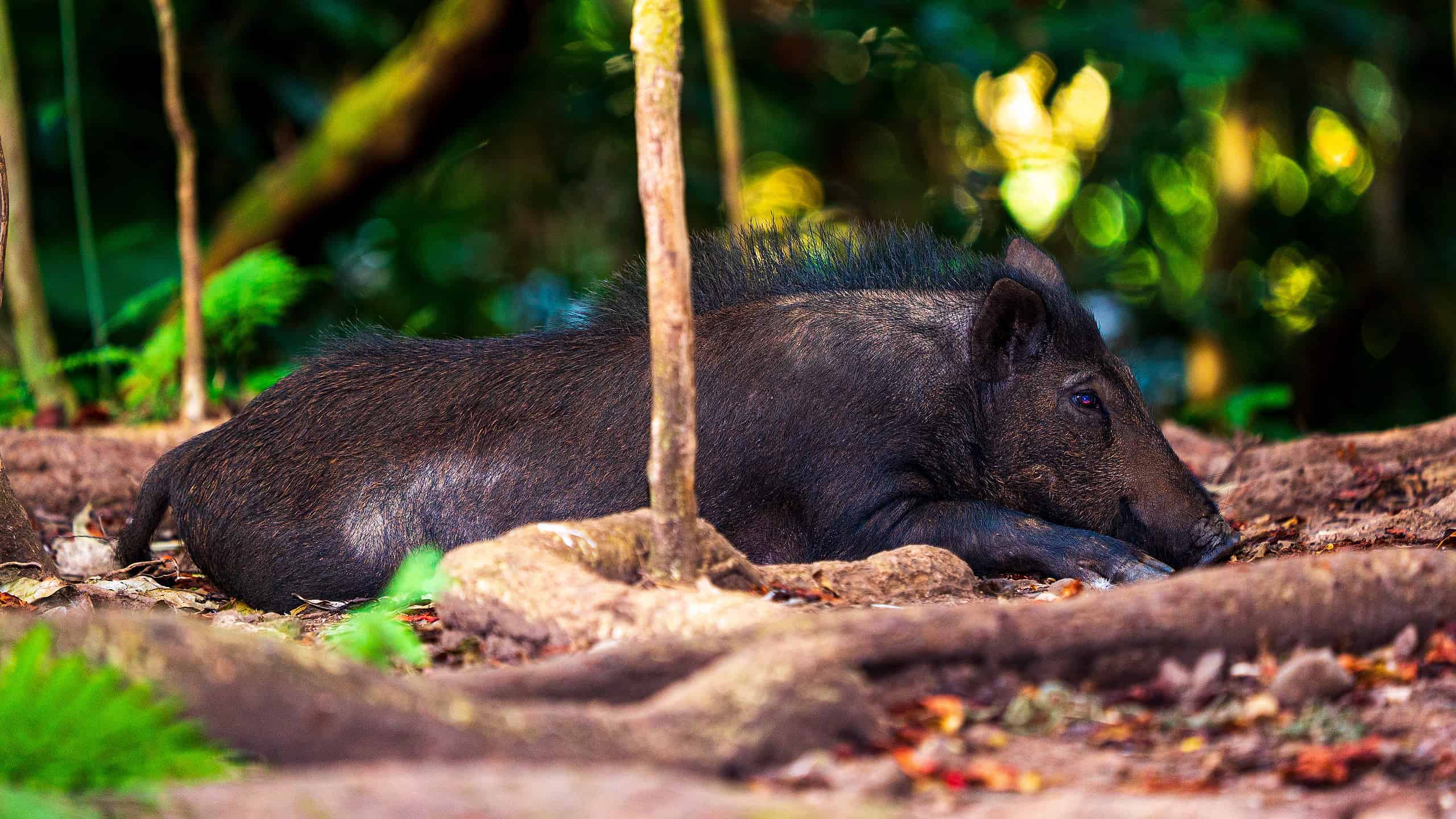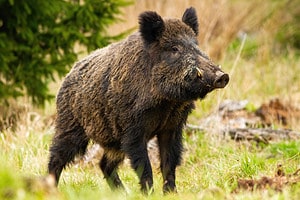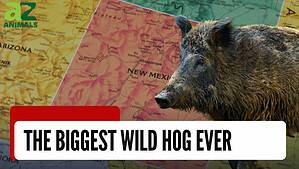Wild boars, feral pigs, wild hogs, wild pigs: all these names fit the pua’a of Hawaii. Along with colorful birds, surfing dudes, gorgeous native plants in many colors, and delicious pineapples, Hawaii is also known for the iconic wild boar. The Polynesian island has a long, intriguing history with the animals and tourists flock to see them (and eat them).
Some folks are surprised to learn that these iconic Hawaiian animals are non-native. Instead, the wild pigs were brought to the island by two different groups in two different eras. The island has never been the same since.
History of Hawaii’s Wild Boars: How Did They Get Here?
It’s believed that the first humans migrated to the Hawaiian islands around 500 to 700 A.D. Coming in double-hulled canoes across thousands of open ocean, the people now known as ancient Polynesians entered the tropical paradise. With them came species of plants and animals from their former homelands. Pua’a, or wild pigs, came first with these people. The animals were then a valuable source of protein, just as they are today. Pigs were introduced and allowed to roam freely within specific confines to keep them controlled and the island safe. Naturally, the mammals are interested in native and non-native crops like taro and sweet potatoes, so they had to be contained to prevent crops from being destroyed. When new fruits (guavas and mangoes) were introduced, the pig population exploded.
About a millennium later, Captain Cook and his crew arrived in 1778. Noting the pigs commonly seen through the islands, he brought European breeds over as well, hoping to increase the size of the pig breed on the island.
The modern wild boars of Hawaii are the descendants of the two breeds imported by the Polynesian people and the Europeans. The feral pigs thrive in the Hawaiian ecosystem and exist on all main islands except Lana’i. Pua’a is considered one of the earliest non-native species in Hawaii. By now, they have become invasive, thanks to the fact that these animals reproduce in vast numbers quickly – with something like 15,000 pigs birthed on average in just five years from a single line.
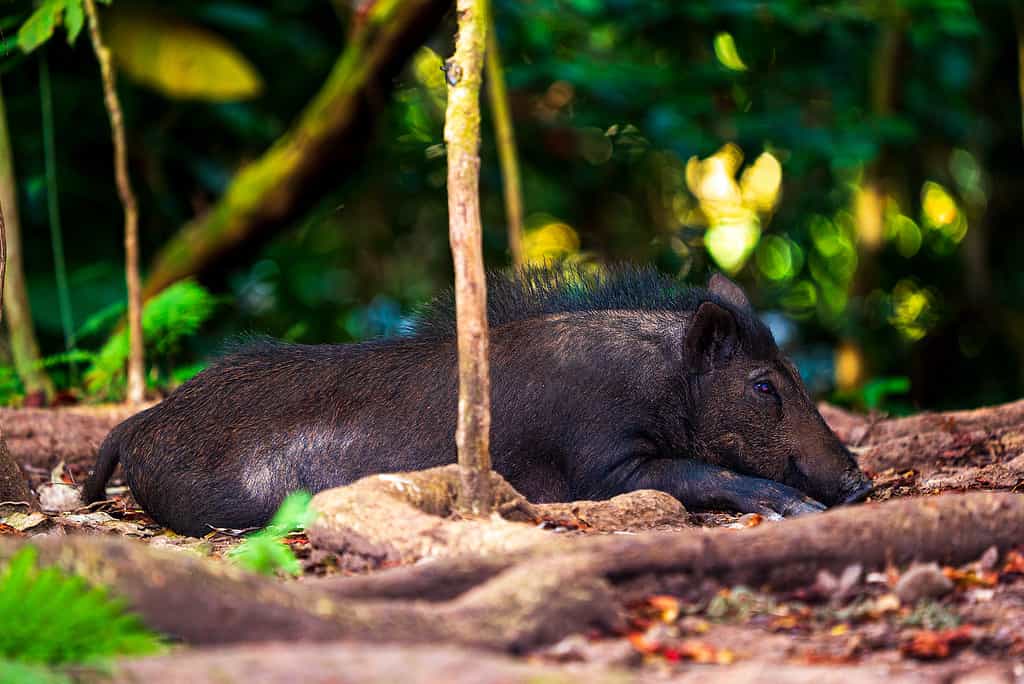
This feral pig relaxing in a rainforest in Hawaii looks chill, but you should never approach one.
©padelphoto/Shutterstock.com
How Many Wild Boar Are There in Hawaii?
According to recent estimates, this thriving species of wild boar has filled out to about 400,000 animals in the Hawaiian islands. The huge number of animals isn’t terribly surprising: pigs are prolific breeders. The average litter size per pig is 7.5, but it’s not uncommon for 12 to 14 piglets to be born.
The gestation period of 114 days (less than 4 months) also means the pigs are capable of reproducing a few times of year, and they often do have two litters annually.
Wild Boars in Hawaii: A Tourist Attraction
Whether you’re looking to personally encounter a feral pig of Hawaii or not, these mammals have become a huge tourist attraction in the state. Several reasons exist for this.
For one, wild boars draw in hunters looking to experience a unique and exciting type of hunt that they probably can’t experience at home. The tropical environment, sandy beaches, and incredible foods of the island don’t hurt for drawing in these hunters, either.
Tourists looking to enjoy unique and intriguing wildlife also are drawn to the idea of spotting boar in the wild. Photographers, both amateur and professional, find opportunities to capture the wild pigs in images around the island.
Additionally, the famed roast pig of Hawaiian luaus draws in tourist crowds for another reason: a delicious meal.
Where Do You See Wild Boars in Hawaii?
While out hiking on any of the main islands of Hawaii, save for Lana’i, you may well hear the call of a feral pig. Your movements on bikes and on foot don’t frighten the mammals. In fact, they aren’t afraid of humans in general and so they are far from elusive.
The pigs are widely distributed across the islands, but mostly they show up in wet forests and open mountain pastures. Foraging for vegetation and insects draws them to wild terrain. Looking for lush fruits and delicious food produced by humans draws them toward the urban areas.
Are Wild Boars Problematic in Hawaii?
Unfortunately, the proliferation of wild boar in Hawaii has created massive problems for islanders. The pigs are a huge threat for multiple reasons, one of the largest being that they do not fear humans. This means they won’t hesitate to roam in heavily populated areas and frequently make themselves a nuisance in urban areas. Acute damage of property, human injuries, and destruction of crops and farm animals may all be attributed to the wild pigs of Hawaii. And particularly, since they travel in hordes, crops are destroyed by the trampling of hundreds of hooves as the pigs slash their way through fields.
Wild Boar in Hawaii: Impact On the Ecosystem
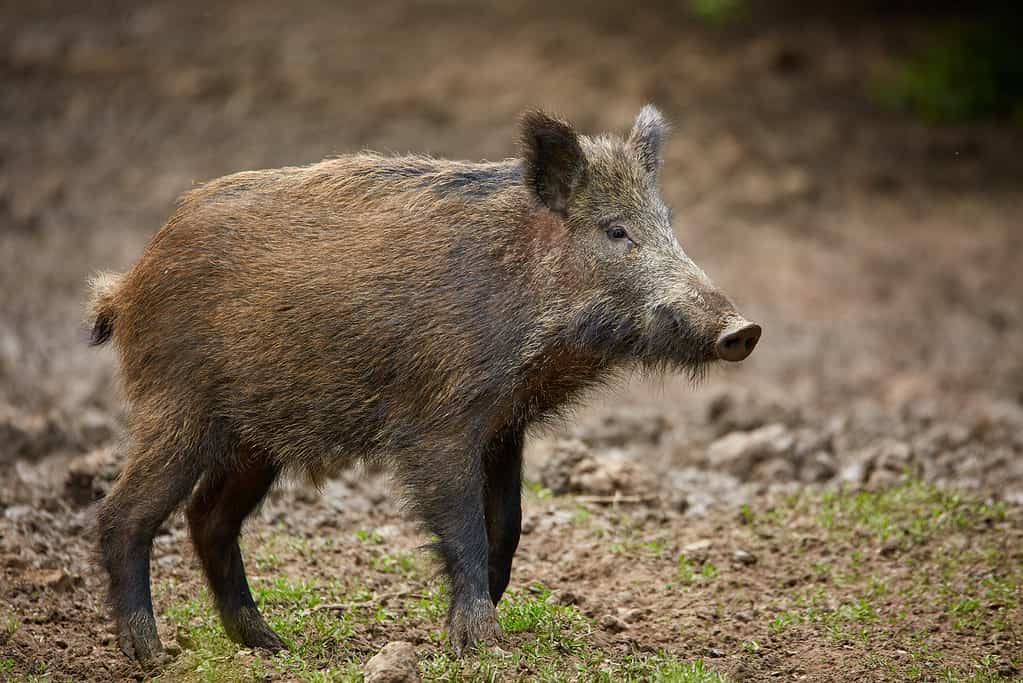
Juvenile wild hogs in the wild look cute, but they’re very dangerous.
©Slatan/Shutterstock.com
The Hawaiian ecosystem is under threat by the wild boar of Hawaii. Searching en masse for huge amounts of food results in the pigs thrashing their way through both natural and cultivated food sources on the islands. Digging up roots and tubers, they destroy the local wild plants as well as crops like sweet potatoes and taros.
Many other native plants are destroyed in the process as well, as the boars churn their way through forested lands and natural meadows. All the rooting and digging also prevent new seeds from spreading and taking root so that new plants can become established.
Wild boars also help to spread mosquitoes. Their digging through hollowed-out trees creates rain catches which in turn collect the rain runoff and attract the flying pests. These hollows become breeding grounds for mosquitoes.
Are Wild Boars a Danger To Humans?
Though they look kind of cute and seem like they should be harmless to humans, wild pigs have the potential to cause extreme harm to humans. Humans, particularly those traveling alone on foot, are the most vulnerable. Pigs travel in groups, especially the females with their piglets. They should be avoided at all costs. Females are protective of their young and become highly aggressive towards humans and other animals if they feel threatened in any way. Since they aren’t generally afraid of humans, they are known to approach urban areas, even with young in tow. That means you are inherently a threat because of being a human. Feral pig attacks may cause severe injury and even death.
Beyond high levels of aggression, wild pigs are also known to carry diseases that may infect humans. E. coli, hepatitis E, influenza A, and brucellosis are among the 45-plus diseases these animals are known to carry and transmit to humans and other animals.
Do Wild Boars of Hawaii Attack People?
Neither male nor female wild boar of Hawaii are more prone to attacking humans than each other. Either may attack humans with no provocation at all, whether they are in herds or roaming solo. Females with young may be more likely to attack, though, if you approach the young. If you see a piglet that is wounded or appears ill, do not approach it under any circumstances. These young are particularly prone to provoking attacks by their parents.
If you see a wild boar while out on foot, you should avoid them at all costs. More than 100 cases of wild pig attacks have been reported in the United States, most of which have been unprovoked. Even in the case of wild pig attacks during hunting sessions, 2 out of 5 attacks will be unprovoked. Some of the wild boar attacks have led to deaths. These are somewhat more likely to be severe when a herd is involved rather than an animal acting alone. The attacks often result in trampling the victim to death or trampling to the point of excessive bleeding which leads to catastrophic blood loss.
How to Avoid Wild Pig Attacks
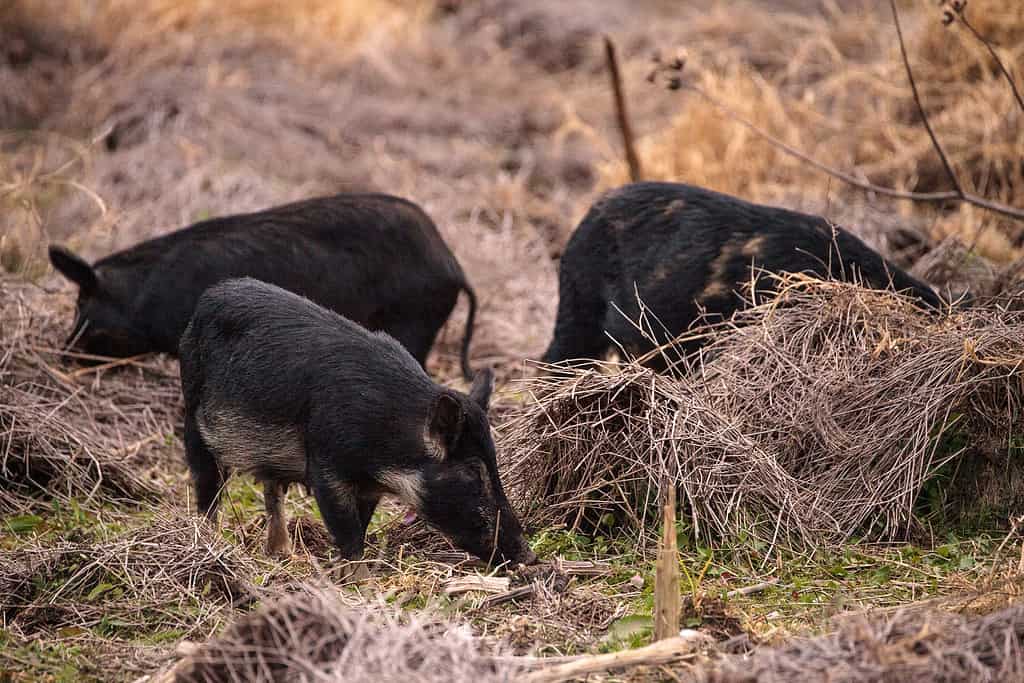
Feral pigs root through hay.
©SunflowerMomma/Shutterstock.com
The overabundant wild boar of Hawaii population means that out on designated hiking trails, there’s a high probability you’ll see pig tracks. Wandering off-trail makes the chance of meeting a wild boar even more likely. Knowing how to avoid encounters with wild boar could help save your life, particularly if you are hiking or biking solo.
Identifying Pig Tracks
Evidence of digging and lots of foot marks is a sign of wild pigs. The hooves of pigs are cloven, meaning divided into two halves with a gap between.
Pigs wallow in muddy rainforest areas, in soil with root vegetables, and in areas with human food waste.
Listen and Pay Attention
Whenever you hike, you should always pay attention to the noises and sensations around you. While out and about in Hawaii, it’s important to keep your head up and look ahead on the trail before you. Often, pigs may be spotted before you get too close.
You should also keep your eyes roving to the sides of the trails. Wild boars may be rustling in the plant life nearby. Trails running off the path may also indicate the presence of pigs in the area, as these are likely created by the boar.
Notice Mud Rubbings
After wallowing in muddy areas looking for dinner, pigs often will rub their bodies against tree trunks and leave behind muddy impressions. These rubbings indicate the presence of a pig in the area — or many — and may give notice of how recently they’ve been there. If the mud rubbings are moist, the pig may well still be very nearby.
The rubbings may also help to indicate the size of the animals in the area.
Jump Out of the Way and Climb a Tree
If a startled pig spots you or one comes barreling down the trail toward you, jump out of the way of the path. Immediately hide behind a tree, or better yet, climb it, if possible. This will help you avoid the charge.
Leave the area immediately and seek protection. Pigs charge at humans, but they also bite and gouge people with their tusks. They’re exceptionally fast and agile for being so large and notoriously lethargic animals.
Pigs and Dogs: What Happens?
Dogs and pigs are rarely friends. In fact, most pigs hate dogs and will avoid them. If you have a dog traveling with you, taking them out on walks with you is an excellent idea. The wild boars of Hawaii will smell the dog with you and avoid you.
Wild Boar Regulations
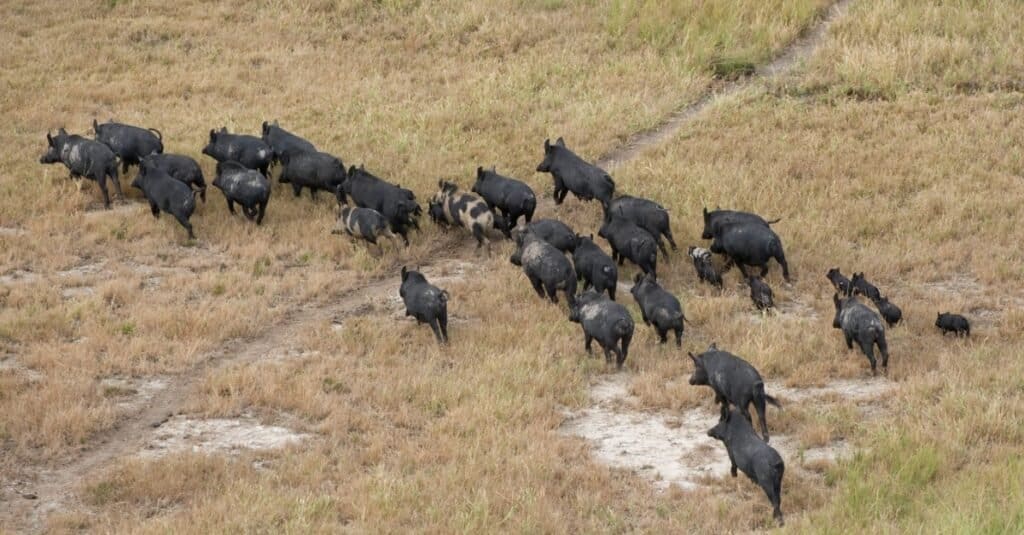
Feral pigs cause a lot of damage to crops and the landscape due to rooting.
©iStock.com/JohnCarnemolla
Because all main islands of Hawaii, save Lana’i have feral swine, regulations from the state government have come into play. The destructive nature of the pigs has helped to encourage hunting of feral hogs both in private and public spaces.
The State of Hawaii has its own regulations regarding the way this land is treated. Each island, as well, will have its own regulations and rules, so it’s important to understand your options and what boundaries and rules exist. Interestingly, non-residents may have an easier time hunting on private lands for wild boar than residents. Guides are required, though, and all regulations must be followed.
Can You Hunt Wild Boar in Hawaii?
Many Hawaiians consider the hunting of wild boar a way of life – or at least a large part of it. The hunting of animals has gone on for centuries, passed along as tradition. For non-residents of Hawaii, hunting guides and experts are typically engaged and may be required by law. If you’re interested in the wild experience of hunting feral hogs, many outfitters exist and provide access to private and public land with lush scenery.
Guides have safety measures in place to help prevent and protect against wild hog attacks and often bring along dogs for an added safety measure. Many companies specifically only use cultural hunting methods, as well, with using dogs and knives, and spears only (no rifles).
Before engaging an outfitter, check their methods and the supplies they provide. Many offer muck boots, safety apparel (including vivid orange shirts or jackets), backpacks, meals and water, and other equipment. If traveling to Hawaii, you may wish to engage one of these outfitters, in particular, to avoid having to travel with extra gear.
Age restrictions will be given (some have a minimum age of 10 years of age) and walking distances required by each given outfitter. Most also require you to acquire your own hunting license and proof of completion of a Hunter Safety Course from your own state of residence.
Wild boar or hog hunting season varies depending on the island. Check dates and regulations per island before planning your trip. Baiting is allowed, night hunting is prohibited, and in most cases, there is no bag limit.
How Do Hawaiians Serve Wild Boar?

A herd of black feral hogs is contained in Hawaii.
©Carolyn Croyle/Shutterstock.com
Of course, if you’re not into hunting but still want to enjoy some amazing wild pork, Hawaii is particularly known for eateries featuring the wild animal. Lau lau or kalua pig, for example, are popular traditional meat choices. Both of the dishes feature pork seasoned with Hawaiian salt. The Lau lau pig uses steamed taro leaves. Kalua pig is roasted in the pit or underground oven known as an imu, and seasoned and served while still hot.
Hawaiian Wild Boar Mythology
Deeply entrenched in the culture of Hawaii, the wild boar even appears in Hawaiian mythology.
Hawaiian lore tells the tale of the illegitimate son born to Hina (mother to the demigod Maui), named Kamapua’a. He was born to Hina and her husband’s brother, resulting in Kamapua’a being disowned and called “Hog-child” by Hina’s husband. The boy grew into a handsome man with shapeshifting abilities. Desiring his father’s approval, he used his skills and charm to attempt the feat. Tattooing his face and cloaking himself in animal skins, he murdered Hina’s husband. But his biological father refused to claim him. Angered and saddened, Kamapua’a used his charms to attract women and then destroyed villages and anyone who crossed him.
But the goddess of fire, Pele, caught his attention and Kamapua’a’s anger dissipated and his former beauty returned. Pele, though, was angered and found his newly restored beauty as competition. She banished him, mercifully, to the other side of the Big Island. The Hog-child survived the eruption of Mount Kilauea but believed his beloved Pele was killed by the lava. Deeply sorrowed, he joined the sea to become the humuhumunukunukuapua’a fish (the state fish) which makes pig-like noises. Children are still told this story and associate the pig-like fish noises with the wild boar of Hawaii and the legend of the Hog-child.
Thank you for reading! Have some feedback for us? Contact the AZ Animals editorial team.

